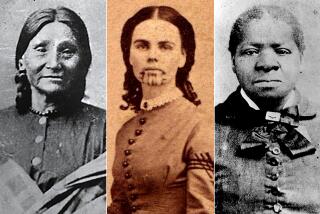‘Frederick Douglass’ by William S. McFeely
Born to an African mother and a European father, Frederick Douglass was, by any standard, one of the extraordinary men of the 19th Century and the most powerful black man of his age.
William McFeely’s compelling biography covers the career of Douglass from his early years at a Tuckahoe, Md., plantation, which he spent with his grandmother, “a strong, copper-dark woman, intelligent and physically powerful,” to his death in 1895.
Some of this is familiar territory, covered in Douglass’ three autobiographies. One can hear Douglass reciting the details of his life: melodramatically satirizing the slave master’s use of the Scriptures to justify the “pernicious” institution; witnessing the cruelty of slave master toward slave (he saw his brother beaten until blood flowed from his ears); besting Edward Covey, a man he called “the nigger breaker,” in a duel.
Unlike many of his black contemporaries, Douglass was able to escape slavery by becoming a spokesperson for the abolitionist movement. It began when he was sent to live as a house servant with the Baltimore family of Hugh and Sophia Auld. (Separated as an infant from his slave mother, Douglass never knew his white father.)
Defying state law, Sophia introduced him to literacy, a key to his freedom. His early Baltimore years provide history with one of its most moving images, that of a 12-year-old slave child purchasing Caleb Bingham’s “Colombian Orator,” a book whose speeches (including Cicero, Cato and William Pitt) Douglass would recall in later years as an anti-slavery orator.
Upon the death of his master, Douglass was returned to the Maryland plantation as a field hand at age 16. Five years later, however, masquerading as a sailor, he fled to New Bedford, Mass., where he worked as a common laborer, successfully eluding slave hunters by taking the name “Douglass,” based on a character in Sir Walter Scott’s poem “The Lady of the Lake.”
Like other fugitive slave intellectuals, Douglass criticized Christian churches for their “hypocrisy,” but it was in the African Methodist Episcopal Church that he developed the oratorical style that would make him an international celebrity. A speech opposing the colonization of African Americans, delivered at a church meeting on March 12, 1839, gained the attention of abolitionist William Lloyd Garrison’s Liberator newspaper, and on Aug. 16, 1841, after being scouted by William C. Coffin, Douglass was brought into the anti-slavery business.
Douglass became a sought-after performer for the anti-slavery agitation, but soon fell into trouble with the abolitionists. Marcus Garvey, a man whom some regard as the father of black nationalism, remarked that it usually is whites who select black political and cultural leaders, but when these “leaders” defy their sponsors, they are dismissed as ungrateful (as Douglass was) or replaced by another “leader.”
Like the white feminists or neo-conservatives of today, who have their own black spokespeople, the abolitionists demanded obedience to a party line. Douglass was their star, and those who were critical of the mouth for hire at that time were dismissed by their sponsors as envious, or unreasonable. But unlike some spokespeople today, Douglass was no puppet for his sponsors. He was regarded as arrogant by anti-slavery groups at the time and viewed with suspicion.
Douglass’ anti-slavery lectures and oratorical style were constantly monitored by the abolitionists. Recalling those today who dismiss black independent thinkers as “paranoid” or given to “race-based denial,” one abolitionist scorned Douglass for being “haughty, self-possessed and prone to take offense.” Douglass also was attacked when he struck up friendships with white women and criticized when he decided to marry one after the death of his black wife, Anne.
In an essay about how New Yorkers reacted when they saw him walking down the street with two white women in 1849, Douglass viewed racism as a mental-health problem: “Colorphobia,” a kind of mental leprosy. With this shrewd observation, Douglass anticipated the efforts of contemporary black psychiatrists to have the medical establishment declare racism a mental-health problem.
Though his insolence and his support of the Constitution annoyed the abolitionists, what finally estranged him from his former allies was his decision to publish his own newspaper (The North Star) rather than depend upon white editors for space in which to air his views.
In contrast to radical black leaders such as Henry Garnett, who called for rebellion against the slave masters, Douglass was a centrist. And yet, while he was a relentless campaigner for the Republican Party, the party rewarded him only with political appointments no one else wanted. As marshal of the District of Columbia under President Rutherford B. Hayes, he was humiliated when one of the job’s duties--greeting visitors to the White House and introducing them to the President--was eliminated. Working for Hayes was one of the many compromises that Douglass the centrist had to make, for Hayes’ administration ended federal protection for the rights of the newly emancipated black people.
Douglass, however, didn’t always play compromiser. He was forced out of his position as ambassador to Haiti, for example, because he refused to be a tool for the expansionist policy of the United States under President Benjamin Harrison. His abuse by the Republican Party after having placed so much faith in it reminds one of Jesse Jackson’s attempt to reform the Democratic Party.
Any black man who speaks frankly from a black male point of view will be regarded as “controversial.” While some saw Douglass as perhaps one of the great orators and statesmen of the 19th Century, he was also seen as a “long yellow devil.” He was regarded as “dangerous” and once, when Thomas Auld, his master, broke up a church class that Douglass was conducting, he was accused of wanting to become another Nat Turner, the self-taught visionary who led a slave rebellion that people still talk about in Virginia.
A black audience booed and hissed at Douglass when he criticized the “exodusters,” blacks who wanted to abandon the south for the west. People objected to his buying of his freedom, claiming that in so doing, he endorsed the slave system. He was criticized for neglecting his family in favor of his political career. He was criticized for visiting Auld after he became a free man. He was criticized for not being black enough (English audiences expected their anti-slavery performers to be dark-skinned, and Douglass was a mulatto). He escaped hanging twice. His house was destroyed by arsonists. He was physically attacked and threatened throughout his life.
After John Brown’s bold and daring capture of the federal arsenal at Harper’s Ferry, Douglass was implicated in the conspiracy. Brown, in fact, was Douglass’ house guest and apparently discussed the plot with Douglass. Douglass found himself pursued by Gov. Wise of Virginia and President James Buchanan, who wanted to capture the most “arrogant” black man in America. Douglass had to flee the country.
McFeely offers a sympathetic portrait of Brown, a Christian who--like Jesus Christ, the scourge of the temple money-lenders--believed that sometimes force had to be employed to eradicate an evil. It is a comment on the political underpinnings of the school curriculum that in the textbooks our children read, Brown is dismissed as a maniac, while Robert E. Lee, who fought to uphold a slave society and under whose command free Pennsylvania blacks were returned to slavery and blacks who fought on the Union’s side were executed and buried in mass graves, is regarded as a hero.
Shelby Foote, narrating the PBS series “The Civil War,” viewed by historian Leon Litwack and others as being pro-Confederacy, even described Maj. Gen. Nathan Bedford Forest as a hero. Forest massacred more than 100 black men, women and children at Fort Pillow. (During an interview with columnist Noah W. Griffin, published in the San Francisco Examiner on Oct. 14, 1990, Foote referred to the black Civil War soldiers as “niggers”).
Douglass made mistakes. He became president of a bank that was involved in shady dealings. He supported a tyrannical regime in Haiti. His courage and brilliance, however, never were questioned. Many of his ideas were ahead of their time.
Douglass, for instance, addressed the need for a multi-ethnic curriculum in the 19th Century. Like those who advocate multicultural education today, he observed that “A Benjamin Franklin, in the eyes of scientific Europe, redeemed the mental mediocrity of our young white Republic, but the genius and learning of Benjamin Banneker of . . . Maryland, the wisdom of Toussaint, are not permitted to do the same service for the colored race to which they belong.” And like our contemporary African-American intellectuals, he criticized the claim that the Egyptians were Caucasian: “I see a much stronger resemblance to the Negro than to the Europeans. They are not the genuine crisp-headed Negro, but they are very much like the mulatto, and would be taken for such in the United States.”
McFeely’s biography is welcomed as the period of American history during which our institutions were dominated by Europeans and European thought comes to a close; a period during which the native population nearly was exterminated, blacks were held in chains and forced to perform slave labor, land was seized from the Mexicans, nuclear weapons were employed against Asians, and Japanese Americans were “interned.”
This engaging and well-written work of literature suggests that the Age of Douglass was this nation’s greatest epoch. People of humble origin transcended themselves. Former slaves rose to greatness and spoke with the eloquence of angels. Abraham Lincoln, our greatest President, ascended from a log cabin to sainthood. European Americans produced their most magnificent Christian, John Brown (whose life certainly deserves a more balanced treatment than that of the dismissive 1940 movie “Santa Fe Trail”).
We were given two great songs: “The Battle Hymn of the Republic” and “Amazing Grace.”
What a time. What a book.
More to Read
Sign up for our Book Club newsletter
Get the latest news, events and more from the Los Angeles Times Book Club, and help us get L.A. reading and talking.
You may occasionally receive promotional content from the Los Angeles Times.






